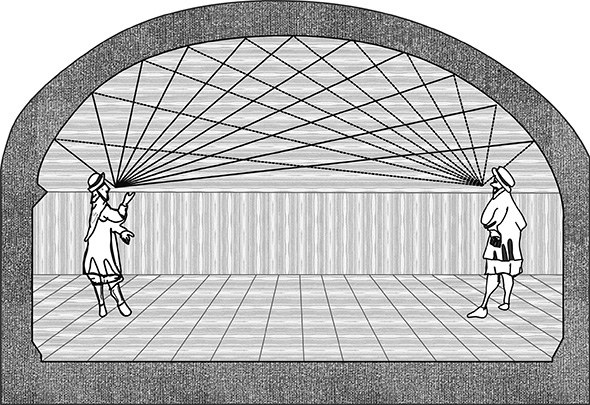This 360 video recorded with Ambisonics (headphones needed) illustrates some of the strange echoes created by the domed ceiling of the circular reading room in Manchester Central Library. What do you notice in the video?
One feature, is that the strength of the focus from the ceiling causes the sound from some instruments to appear to arrive from the wrong place. For example, if you look at the bongo player about 40s in (they are down and to the left of the opening shot from the video), you’ll hear how the echo from the dome appears to come from a different place.
With a dome above you, there is focussing that amplifies the sound bouncing from the ceiling. The marimba in the video is behind the big wooden object with the four columns on top. But the microphone is roughly at the focal point of the ceiling reflection for the marimba, and hence the instrument can be clearly heard despite being invisible.

The piece is ‘Pillars of Wisdom’ by Prof Alan Williams (@AlanWilliams123). The piece plays with the slap-back echo from the dome that is delayed by about a fifth of a second. Initially, it was difficult for Gravity Percussion to perform because of the echo making coordinating timing awkward. After a short rehearsal where the wooden structure made it impossible to see one another, they moved the instruments about so they could see each other to coordinate playing.
In fact, depending on where you heard the piece, the two percussionists were almost inevitably out of time. It is the same problem you get when they try and sing the national anthem at a football game, the time it takes sound to travel around the ground makes it impossible for people to sing together. Pillars of Wisdom explicitly uses the echo delay in its rhythm, and for that reason, the instrumentalists being out of sync doesn’t matter and forms part of the piece – you might not have even noticed if I hadn’t pointed it out!
The recording was done for the Manchester Science Festival 2016 as part of the Playing the Echo event. Sound and video was by myself and Danny Wong-Mcsweeney of Acoustic Research Centre, University of Salford. Audience members could wander the room to find different listening experiences depending on whether they were near a dome focus or not.
The recording technique used is described in a previous post. The original surround sound format is converted to binaural by YouTube, so as well as the original acoustic phenomenon, you can listen for artifacts that appear due to the VR rendering.
Next time, I’d like to have a roving mic to pick up the changing acoustic around the room. Maybe I should try doing this in an even more extreme acoustic, maybe Teufelsberg where there is an almost spherical room, or the Oslo train station with the odd warble. Where would you record?
0 responses to “Playing the Echo”
I’m guessing it’s probably been done before but St. Pauls
‘Whispering Gallery’ seems like it would yield interesting results. I went there in 1990 as a high school student and that was an early experience for me in how sound can behave in play with archutecture…